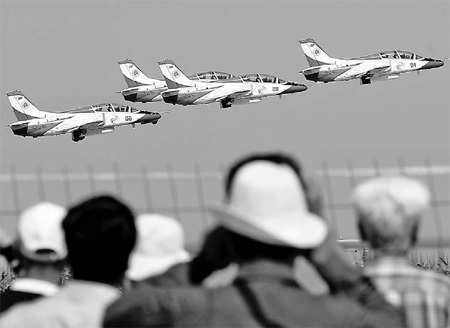Aerobatic teams to have key role in recruitment of pilots
|
Spectators watch four K-8 trainers of the Red Falcon Demonstration Team flying past at the welcoming ceremony for newly recruited student pilots of the Aviation University of the People's Liberation Army Air Force on Thursday. Fang Xinwu / for China Daily |
Higher standards for student airmen lead to shortage of college applicants
CHANGCHUN - All three of the country's aerobatic demonstration teams gathered at an air show on Thursday in Changchun, capital of Northeast China's Jilin province, in a bid to present the Chinese air force's modern image and to reignite young people's interests in joining the force.
The air show, part of a welcoming ceremony for 1,101 newly recruited student pilots of the Aviation University of the People's Liberation Army (PLA) Air Force, also staged the debut of the two new aerial demonstration teams established in March but announced just last week.
The Sky Wing, affiliated with the aviation university, and the Red Falcon, affiliated with the No 3 Aviation College of the People's Liberation Army, performed on Thursday with domestically developed CJ-6 and K-8 trainers, along with the 50-year-old August First Air Demonstration Team of the PLA Air Force that performs with the new J-10 fighters.
The university organizes a welcoming ceremony for freshmen each year, but this was the first time an air show had been staged for them.
The air show will "give a boost to pilot recruitment", which has become more difficult as the air force has raised the threshold for pilot applicants in recent years, said Wu Xiangfeng, director of the political department of the university, where all air force pilots study during initial training.
Starting this year, high school graduates who apply to become a student pilot for the air force must get a score in the national college entrance exam that is high enough for entrance to a non-military college.
Peng Junxia, head of the air force's recruitment department, said earlier that the change in recruitment policy was due to the air force's fighter aircraft becoming more advanced. Pilots for these planes must have profound knowledge of technology and combat skills.
The air force has expanded its recruitment pool in recent years, but Wu said the recruiting job is "getting difficult".
"Under education pressure, two-thirds of Chinese high school graduates do not have good enough eyesight to become a fighter pilot, not to mention other physical and mental requirements," he said.
Wu added that only 200 to 300 of high school graduates reach the eyesight standards set by the air force.
Lu Jian, a member of Sky Wing, said: "We hope we can show youngsters that this is a cool man's job and therefore attract more to the air force."
Lu Yabing, head of the Red Falcon team, said aerobatic performers have to master much more difficult skills than pilots learn in regular training, which usually involves one or two trainer aircraft at a time. Aerobatic teams practice in groups of up to eight aircraft, often with only a few meters separating them.
Shan Shengzhe, 21, a student pilot at the aviation university who has finished two years of theoretical studies and will soon learn to fly a trainer aircraft, said the aerobatic performance was thrilling.
"The usual training involves simple moves, but the aerial performance right in front of my eyes was thrilling and made me look forward to flying," he said.
Using CJ-6, a two-seat start-level trainer aircraft, Sky Wing has 16 members, each with a record of flying more than 2,000 hours. Red Falcon, using a subsonic jet K-8 trainer, has 18 members, each with a history of flying more than 1,200 hours.



















